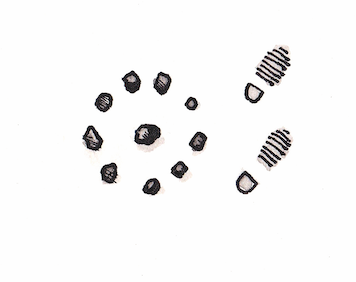Oh, for the halcyon days of scout camp. Living unwashed in a field for a week, playing with knives and fire, trading contraband, subsisting on fry-ups and E-numbers. Veterans of this wholesome experience will probably also have enjoyed the classic scouting game of tracking a trail, where you try to find your way to a secret location by following improvised symbols made from natural materials like twigs and stones.
Directions
Arrows constructed out of sticks are the most helpful way to give directions, but less fun for this same reason. Subtler tactics include tying a tuft of grass to point the right way, or placing one rock on top of another then using a third rock to indicate direction. This latter arrangement is particularly difficult to distinguish from any old pile of stones, and has been responsible for many a wild goose chase.
Help and hazards
Show-offs have a wider range of symbols at their disposal, including zig- zags to indicate water, or parallel lines for an obstacle. A generous scout might leave a cache or message for friends on their trail, marked by a square with an arrow coming off it. Sticks or stones placed inside the square indicate the number of paces to the drop – possibly a melted Mars bar or a dog-eared Point Horror sealed up in a sandwich bag.
Gone home
A dot in a circle means that the scout has finished laying his trail and ‘gone home’, perhaps pausing to enjoy a crafty cig while his companions are hopelessly lost in the woods. This symbol has an extra poignancy for scouters, since it’s also a euphemism for death. To this day, if you get an email about an old scout leader with ‘gone home’ in the subject line, it means their trail is at an end.
Words and illustrations by Joly Braime



